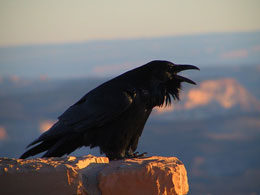"Weedy" Bird Species May Win as Temperatures Rise
JUNE 9, 2010
By Susan Brown

Large birds like this common raven increase their early winter range in warmer years
Credit: National Park Service
Climate change is altering North American winter bird communities in ways that models currently favored by ecologists fail to predict.
Based on patterns of animals found in different climate zones today, ecologists would expect that as habitats warm, numbers of species found there will increase, and that those species will be smaller in size and restricted to narrower geographic ranges. Ecologists at the University of California, San Diego have found that only one of those three predictions has held for North American birds over the past quarter century.
Instead, their analysis has revealed that warmer weather has favored "weedy" species, those that are adapted to a wide range of habitats and therefore easily extend their ranges. Larger birds, which are typically better dispersers than smaller species, seem to have gained an advantage, they report in the early online edition of the Proceedings of the Royal Society B June 10.
"The changes, at least initially, are likely to favor generalist species, those in the best position to respond to changes," said Frank La Sorte, a post-doctoral fellow at UC San Diego and first author of the paper. "It's going to be difficult using existing spatial ecological patterns to predict the outcome of climate change."
The team based their assessment on the annual Christmas Bird Count, an event organized by the National Audubon Society in which volunteers note which birds are present within a 24 kilometer wide circle in their communities over a 24-hour period in early winter, relying on either sight or sound to identify the species.

Birders have sighted American robins in more locations in their annual Christmas Bird Count
Credit: Ken Thomas
The team found 404 sites throughout North America where birders surveyed every year between 1975 and 2001. Over that period of time, the average annual temperature of these communities increased by nearly one degree Celsius.
As spatial models predict, the numbers of species counted at each site grew as temperature climbed. But that increase could be attributed to larger and more widespread species becoming more common, a pattern not reflected by differences between ecological communities found in warmer versus cooler parts of the world.
The observation suggests that weedy species may win in a warmer world, at least initially. But it also warns ecologists that they may need to revise their models when planning conservation in the face of global climate change.
"Biodiversity is under severe threat from climate change, and the lack of long-term data makes accurate forecasting of likely impact notoriously difficult," said Walter Jetz, associate professor of biology at UC San Diego and senior author of the paper. "Our study illustrates the limitations of using spatial relationships that were established over millennia to model the ecological consequences of current climate change, which is proceeding at a very rapid rate. Rigorous assessment will require much more extensive, long-term monitoring of ecological communities."
Co-authors also include Tien Ming Lee and Hamish Wilman, both members of Jetz's research group. The National Science Foundation supported the project.
Media Contact:- Susan Brown, sdbrown@ucsd.edu, (858) 246-0161
- Frank La Sorte, flasorte@ucsd.edu, (858) 534-6659 or
- Walter Jetz, wjetz@ucsd.edu, (858) 822-6731
